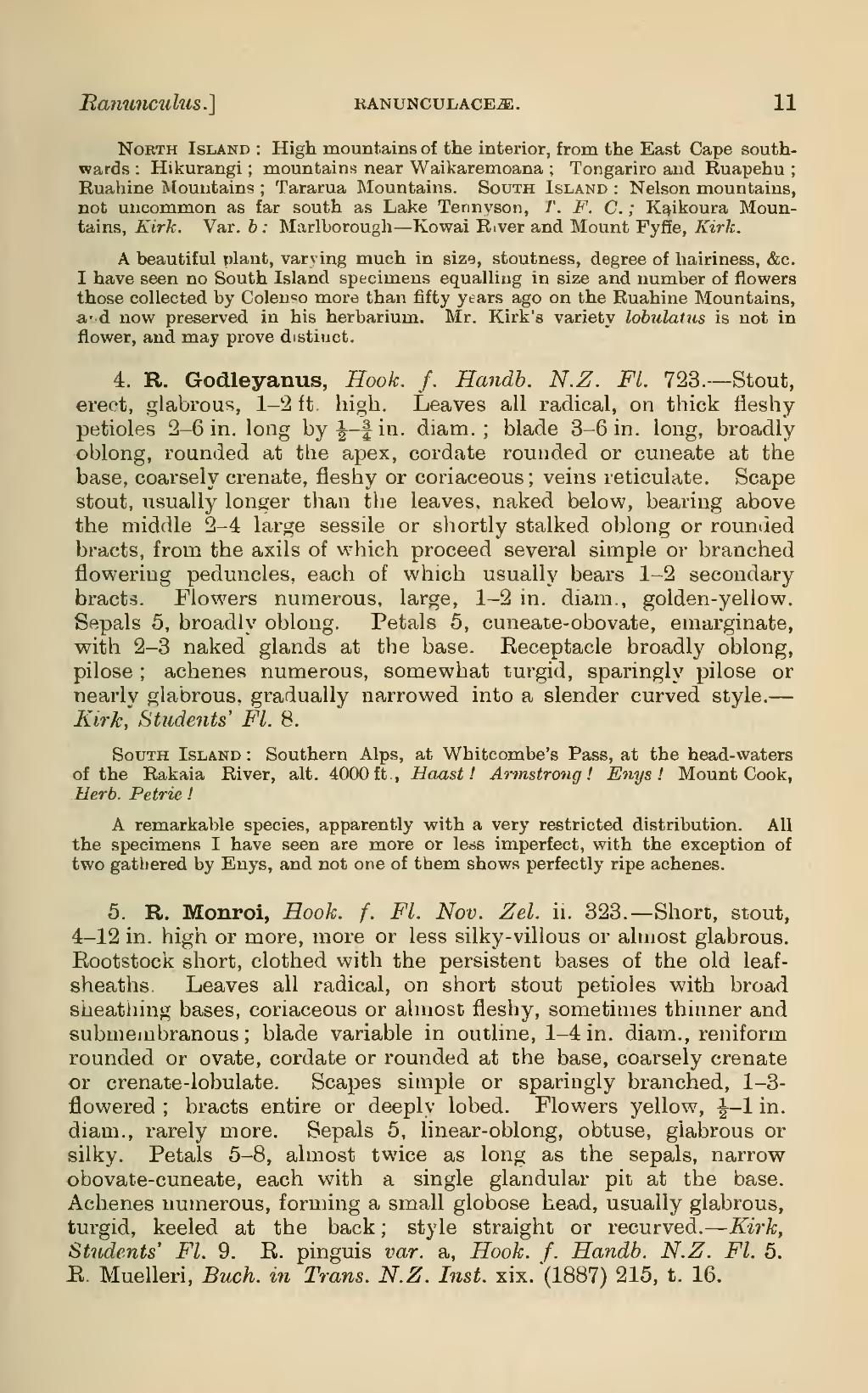North Island: High mountains of the interior, from the East Cape southwards: Hikurangi; mountains near Waikaremoana; Tongariro and Ruapehu; Ruahine Mountains; Tararua Mountains. South Island: Nelson mountains, not uncommon as far south as Lake Tennyson, T. F. C.; Kaikoura Mountains, Kirk. Var. b: Marlborough—Kowai River and Mount Fyffe, Kirk.
A beautiful plant, varying much in size, stoutness, degree of hairiness, &c. I have seen no South Island specimens equalling in size and number of flowers those collected by Colenso more than fifty years ago on the Ruahine Mountains, and now preserved in his herbarium. Mr. Kirk's variety lobulatus is not in flower, and may prove distinct.
4. R. Godleyanus, Hook. f. Handb. N.Z. Fl. 723.—Stout, erect, glabrous, 1–2 ft. high. Leaves all radical, on thick fleshy petioles 2–6 in. long by ½–¾ in. diam.; blade 3–6 in. long, broadly oblong, rounded at the apex, cordate rounded or cuneate at the base, coarsely crenate, fleshy or coriaceous; veins reticulate. Scape stout, usually longer than the leaves, naked below, bearing above the middle 2–4 large sessile or shortly stalked oblong or rounded bracts, from the axils of which proceed several simple or branched flowering peduncles, each of which usually bears 1–2 secondary bracts. Flowers numerous, large, 1–2 in. diam., golden-yellow. Sepals 5, broadly oblong. Petals 5, cuneate-obovate, emarginate, with 2–3 naked glands at the base. Receptacle broadly oblong, pilose; achenes numerous, somewhat turgid, sparingly pilose or nearly glabrous, gradually narrowed into a slender curved style.—Kirk, Students' Fl. 8.
South Island: Southern Alps, at Whitcombe's Pass, at the head-waters of the Rakaia River, alt. 4000ft., Haast! Armstrong! Enys! Mount Cook, Herb. Petrie!
A remarkable species, apparently with a very restricted distribution. All the specimens I have seen are more or less imperfect, with the exception of two gathered by Enys, and not one of them shows perfectly ripe achenes.
5. R. Monroi, Hook. f. Fl. Nov. Zel. ii. 323.—Short, stout, 4–12 in. high or more, more or less silky-villous or almost glabrous. Rootstock short, clothed with the persistent bases of the old leaf-sheaths. Leaves all radical, on short stout petioles with broad sheathing bases, coriaceous or almost fleshy, sometimes thinner and submembranous; blade variable in outline, 1–4 in. diam., reniform rounded or ovate, cordate or rounded at the base, coarsely crenate or crenate-lobulate. Scapes simple or sparingly branched, 1–3-flowered; bracts entire or deeply lobed. Flowers yellow, ½–1 in. diam., rarely more. Sepals 5, linear-oblong, obtuse, glabrous or silky. Petals 5–8, almost twice as long as the sepals, narrow obovate-cuneate, each with a single glandular pit at the base. Achenes numerous, forming a small globose head, usually glabrous, turgid, keeled at the back; style straight or recurved.—Kirk, Students' Fl. 9. R. pinguis var. a. Hook. f. Handb. N.Z. Fl. 5. R. Muelleri, Buch. in Trans. N.Z. Inst. xix. (1887) 215, t. 16.
